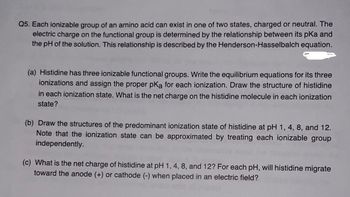
Biochemistry
9th Edition
ISBN: 9781319114671
Author: Lubert Stryer, Jeremy M. Berg, John L. Tymoczko, Gregory J. Gatto Jr.
Publisher: W. H. Freeman
expand_more
expand_more
format_list_bulleted
Question

Transcribed Image Text:Q5. Each ionizable group of an amino acid can exist in one of two states, charged or neutral. The
electric charge on the functional group is determined by the relationship between its pka and
the pH of the solution. This relationship is described by the Henderson-Hasselbalch equation.
(a) Histidine has three ionizable functional groups. Write the equilibrium equations for its three
ionizations and assign the proper pKa for each ionization. Draw the structure of histidine
in each ionization state. What is the net charge on the histidine molecule in each ionization
state?
(b) Draw the structures of the predominant ionization state of histidine at pH 1, 4, 8, and 12.
Note that the ionization state can be approximated by treating each ionizable group
independently.
(c) What is the net charge of histidine at pH 1, 4, 8, and 12? For each pH, will histidine migrate
toward the anode (+) or cathode (-) when placed in an electric field?
Expert Solution
This question has been solved!
Explore an expertly crafted, step-by-step solution for a thorough understanding of key concepts.
Step by stepSolved in 5 steps with 12 images

Knowledge Booster
Similar questions
- 5. Refer to Model 2 for information relevant to this question. A sample of the peptide Lys-Glu-Ser has a net charge of zero between what two pH values? What is the pl of Lys-Glu-Ser? Model 2: The pl of a peptide is determined by examining the ionizable groups. The protonated and unprotonated forms of each ionizable group are in equilibrium. Consider the peptide Lys-Glu-Ser shown below at pH 7.2. The complete structure is on on the left and a stylized structure with just the ionizable groups is on the right. While the N-terminal is depicted as protonated, a sample of Lys-Glu-Ser is composed of a population of molecules and within that population some molecules contain a non-protonated N-terminal group at pH 7.2. may H3N* COO- H3N-CH-CIN-CH C N-CH C- H. pK 3.5 OH H. pK= 8.5 COO- CH2 CH2 CH2 NH, pK 10.0 pK 4.2 CH2 CH2 OH CH2 c=0arrow_forwardCan you please explain how to solve this problem?arrow_forwardA protein has a dissociation equilibrium constant equal to 4.0um. What is the concentration of free ligand when the fraction of bound sites is 0.7arrow_forward
- 1. Make a series (at least 3) of drawings to show the three dehydration synthesis reactions that take place between the two Fatty Acids, the Phosphate Head and the Glycerol. Show the water molecules made. a) Label the following on the completed phospholipid: hydrophilic and hydrophobic parts of the molecule, fatty acids, phosphate group, and glycerol. b) Compare the structure of the phospholipid to that of a triglyceride. How are the two molecules Similar? How are they different? 2. Use the following vocabulary to label and draw a cell membrane: cytoplasm (cell lumen) extra-cellular fluid hydrophobic hydrophilic polar head non-polar tails a) How many O-H groups are there? And are the O-H areas of sucrose polar or non-polar? b) What is the term that is used to discuss how tightly or loosely an atom's nucleus has a hold of its valence electrons?arrow_forward2. | Calculate the overall charge (pH 7) on the following three polypeptides and answer the questions below. Assume the following pKa values: N-terminal –NH3®, 7.0; all -COOH groups, 4.0; Arg, 12.5; Cys, 8.4; His, 6.0; Lys, 10.0; Tyr, 10.0. (A) Ser-Tyr-Ser-Met-Glu-His-Phe-Arg-Trp-Gly-Lys–Pro–Val–Gly–Lys–Lys–Arg-Arg-Pro-Val-Lys–Val-Tyr-Pro-Asp-Ala -Gly- Glu-Asp-GIn– Ser-Ala-Glu-Ala-Phe-Pro-Leu-Arg-Glu-Phe (B) Ser-Tyr-Ser-Met-Glu-His-Phe-Arg-Trp-Gly-Ala-Pro-Val-Gly-Glu-Glu–Cys-Asp-Pro-Val-Glu–Val–Tyr-Pro-Asp- Ala-Gly-Glu-Asp-Gln-Ser-Ala-Glu-Ala-Phe-Pro-Leu-Glu-Phe-Cys-Ser-Tyr-Ser-Met-Glu–His-Phe-Asp-Trp-Gly- Asp-Pro-Val-Gly-Pro-Asp-Ala-Gly-Asp-Gln-Pro-Val–Gly–Glu-Glu-Cys-Asp-Pro–Val-Glu–Val–Tyr-Pro-Asp-Ala (C) Gly-Ser-Val-Arg-Asp-Pro-Val-Lys-Glu-Val-Tyr-Pro-Asp- Lys–Ala-Gly-Arg-Glu-Ser-Arg-Ala (d) Which of the three peptides would migrate the closest to the anode in isoelectric focusing? (e) Which of the above peptides would elute last from a gel filtration column? (f) Which of the three…arrow_forward20. The dissociation constant of protein Z for ligand Y is: 10 micromolar. What fraction of the ligand is bound at ligand concentration = 5 micromolar?arrow_forward
arrow_back_ios
arrow_forward_ios
Recommended textbooks for you
 BiochemistryBiochemistryISBN:9781319114671Author:Lubert Stryer, Jeremy M. Berg, John L. Tymoczko, Gregory J. Gatto Jr.Publisher:W. H. Freeman
BiochemistryBiochemistryISBN:9781319114671Author:Lubert Stryer, Jeremy M. Berg, John L. Tymoczko, Gregory J. Gatto Jr.Publisher:W. H. Freeman Lehninger Principles of BiochemistryBiochemistryISBN:9781464126116Author:David L. Nelson, Michael M. CoxPublisher:W. H. Freeman
Lehninger Principles of BiochemistryBiochemistryISBN:9781464126116Author:David L. Nelson, Michael M. CoxPublisher:W. H. Freeman Fundamentals of Biochemistry: Life at the Molecul...BiochemistryISBN:9781118918401Author:Donald Voet, Judith G. Voet, Charlotte W. PrattPublisher:WILEY
Fundamentals of Biochemistry: Life at the Molecul...BiochemistryISBN:9781118918401Author:Donald Voet, Judith G. Voet, Charlotte W. PrattPublisher:WILEY BiochemistryBiochemistryISBN:9781305961135Author:Mary K. Campbell, Shawn O. Farrell, Owen M. McDougalPublisher:Cengage Learning
BiochemistryBiochemistryISBN:9781305961135Author:Mary K. Campbell, Shawn O. Farrell, Owen M. McDougalPublisher:Cengage Learning BiochemistryBiochemistryISBN:9781305577206Author:Reginald H. Garrett, Charles M. GrishamPublisher:Cengage Learning
BiochemistryBiochemistryISBN:9781305577206Author:Reginald H. Garrett, Charles M. GrishamPublisher:Cengage Learning Fundamentals of General, Organic, and Biological ...BiochemistryISBN:9780134015187Author:John E. McMurry, David S. Ballantine, Carl A. Hoeger, Virginia E. PetersonPublisher:PEARSON
Fundamentals of General, Organic, and Biological ...BiochemistryISBN:9780134015187Author:John E. McMurry, David S. Ballantine, Carl A. Hoeger, Virginia E. PetersonPublisher:PEARSON

Biochemistry
Biochemistry
ISBN:9781319114671
Author:Lubert Stryer, Jeremy M. Berg, John L. Tymoczko, Gregory J. Gatto Jr.
Publisher:W. H. Freeman

Lehninger Principles of Biochemistry
Biochemistry
ISBN:9781464126116
Author:David L. Nelson, Michael M. Cox
Publisher:W. H. Freeman

Fundamentals of Biochemistry: Life at the Molecul...
Biochemistry
ISBN:9781118918401
Author:Donald Voet, Judith G. Voet, Charlotte W. Pratt
Publisher:WILEY

Biochemistry
Biochemistry
ISBN:9781305961135
Author:Mary K. Campbell, Shawn O. Farrell, Owen M. McDougal
Publisher:Cengage Learning

Biochemistry
Biochemistry
ISBN:9781305577206
Author:Reginald H. Garrett, Charles M. Grisham
Publisher:Cengage Learning

Fundamentals of General, Organic, and Biological ...
Biochemistry
ISBN:9780134015187
Author:John E. McMurry, David S. Ballantine, Carl A. Hoeger, Virginia E. Peterson
Publisher:PEARSON